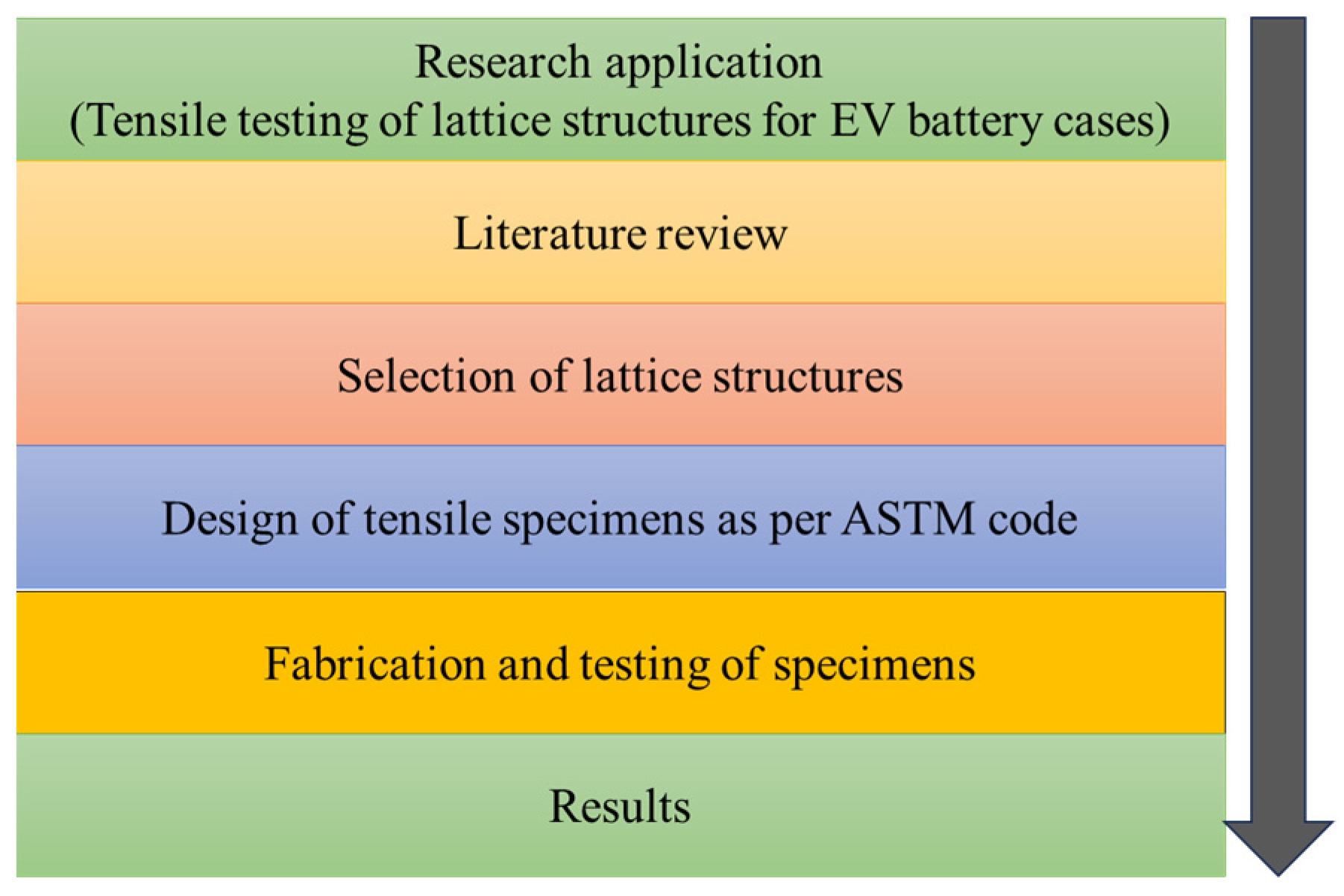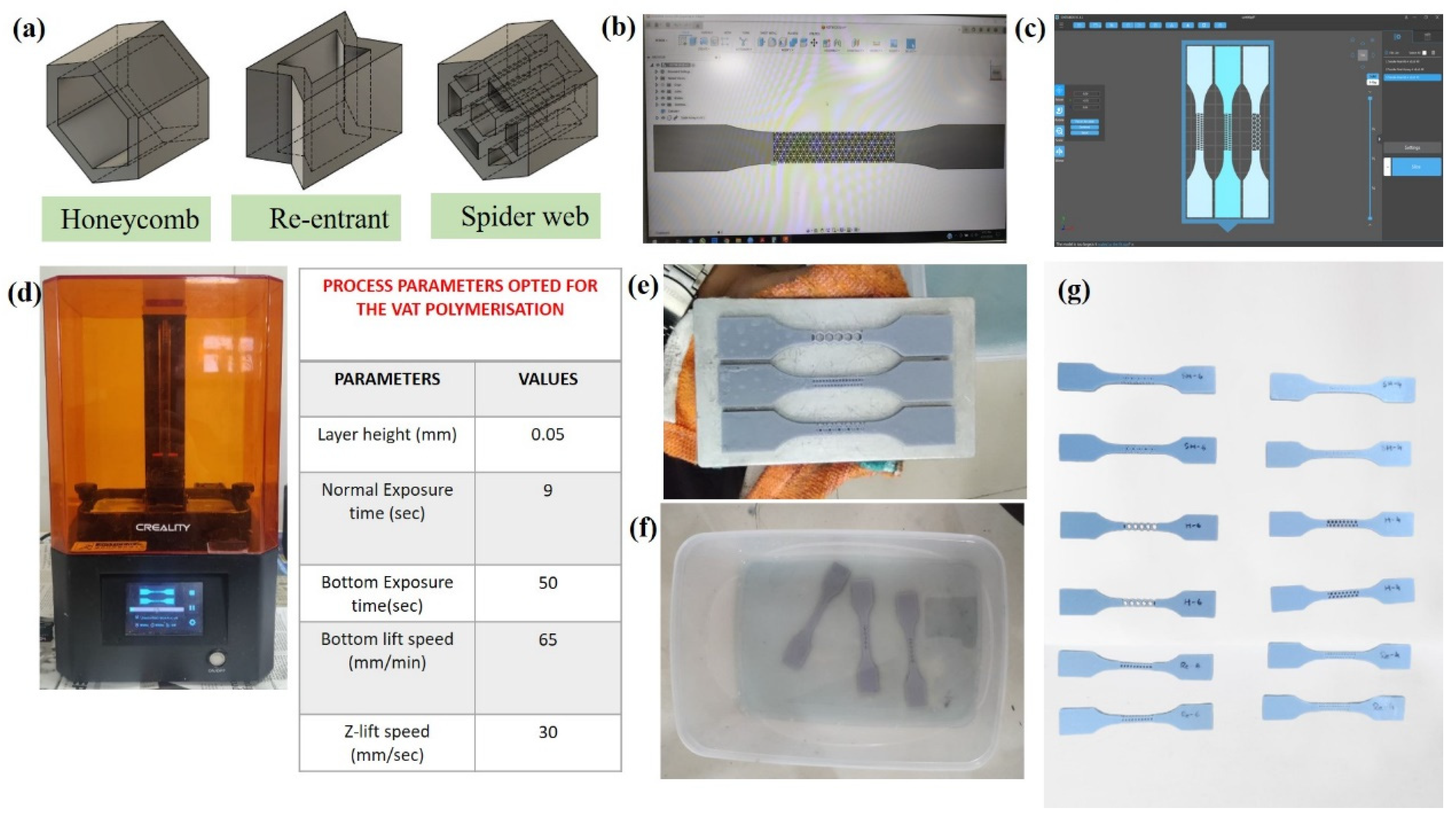Performance Evaluation of Bio-Inspired Pattern-Based Tensile Specimens for Lightweight Electric Vehicle Battery Applications †
Abstract
:1. Introduction
2. Materials and Method
3. Results
4. Conclusions and Future Scope
Author Contributions
Funding
Institutional Review Board Statement
Informed Consent Statement
Data Availability Statement
Conflicts of Interest
References
- San Ha, N.; Lu, G. A review of recent research on bio-inspired structures and materials for energy absorption applications. Compos. Part B Eng. 2020, 181, 107496. [Google Scholar]
- Ramakrishna, D.; Bala Murali, G. Bio-inspired 3D-printed lattice structures for energy absorption applications: A review. Proc. Inst. Mech. Eng. Part L J. Mater. Des. Applications. 2023, 237, 503–542. [Google Scholar] [CrossRef]
- Saiteja, P.; Ashok, B. Critical review on structural architecture, energy control strategies and development process toward optimal energy management in hybrid vehicles. Renew. Sustain. Energy Rev. 2022, 157, 112038. [Google Scholar] [CrossRef]
- Gurusamy, A.; Ashok, B. Establishment of electric two-wheeler driving cycle for energy economy and life cycle assessment under Indian Tier-2 city driving environments. Sustain. Energy Technol. Assess. 2024, 66, 103826. [Google Scholar] [CrossRef]
- Gültekin, E.; Yahşi, M. Dynamic compression and impact analyses of the lattice structures for battery safety. Proc. Inst. Mech. Eng. Part D J. Automob. Eng. 2023, 237, 930–940. [Google Scholar] [CrossRef]
- Nasrullah, A.H.; Puji Santosa, S.; Widagdo, D.; Arifurrahman, F. Structural Lattice Topology and Material Optimization for Battery Protection in Electric Vehicles Subjected to Ground Impact Using Artificial Neural Networks and Genetic Algorithms. Materials 2021, 14, 7618. [Google Scholar] [CrossRef] [PubMed]
- He, Q.; Feng, J.; Chen, Y.; Zhou, H. Mechanical properties of spider-web hierarchical honeycombs subjected to out-of-plane impact loading. J. Sandw. Struct. Mater. 2020, 22, 771–796. [Google Scholar] [CrossRef]
- Mousanezhad, D.; Ebrahimi, H.; Haghpanah, B.; Ghosh, R.; Ajdari, A.; Hamouda, A.M.S.; Vaziri, A. Spiderweb honeycombs. Int. J. Solids Struct. 2015, 66, 218–227. [Google Scholar] [CrossRef]
- Logakannan, K.P.; Ramachandran, V.; Rengaswamy, J.; Ruan, D. Dynamic performance of a 3D re-entrant structure. Mech. Mater. 2020, 148, 103503. [Google Scholar] [CrossRef]
- Evans, K.E.; Caddock, B.D. Microporous materials with negative Poisson’s ratios. II. Mechanisms and interpretation. J. Phys. D Appl. Phys. 1989, 22, 1883. [Google Scholar] [CrossRef]
- Doodi, R.; Balamurali, G. Experimental and analytical investigation of bio-inspired lattice structures under compressive loading. Eng. Res. Express. 2023, 5, 035035. [Google Scholar] [CrossRef]
- Dara, A.; Johnney Mertens, A.; Raju Bahubalendruni, M.V.A. Characterization of penetrate and interpenetrate tessellated cellular lattice structures for energy absorption. Proc. Inst. Mech. Eng. Part L J. Mater. Des. Applications. 2023, 237, 906–913. [Google Scholar] [CrossRef]
- Ramakrishnan, R.; Hemanth Kumar, J.; Titus, F.; Maharshi, P.; Nithish, R. Experimental investigation of 3D printed bio-inspired Xylotus lattice structure for energy absorption under quasi-static axial loading conditions. Proc. Inst. Mech. Eng. Part L J. Mater. Des. Appl. 2024. [CrossRef]
- Bagewadi, S.S.; Bhagchandani, R.K. Effect of gradient structure on additively manufactured auxetic and hybrid auxetic structure for energy absorption applications. Proc. Inst. Mech. Eng. Part L J. Mater. Des. Applications. 2023, 237, 1739–1751. [Google Scholar] [CrossRef]
- Doodi, R.; Gunji, B.M. Prediction and experimental validation approach to improve performance of novel hybrid bio-inspired 3D printed lattice structures using artificial neural networks. Sci. Rep. 2023, 13, 7763. [Google Scholar] [CrossRef] [PubMed]
- ASTM D638-14; Standard Test Method for Tensile Properties of Plastics. ASTM International: West Conshohocken, PA, USA, 2014.



| Types of Lattice Structures | Honeycomb Structures | Re-Entrant Structures | Spiderweb Honeycomb Structures |
|---|---|---|---|
| 4 mm cell size | |||
| Extension (mm) | 2.057667 | 1.749667 | 1.703667 |
| Load (N) | 83.378 | 194.771 | 205.043 |
| 6 mm cell size | |||
| Extension (mm) | 2.013333 | 1.385 | 1.379667 |
| Load (N) | 77.155 | 152.36 | 194.696 |
Disclaimer/Publisher’s Note: The statements, opinions and data contained in all publications are solely those of the individual author(s) and contributor(s) and not of MDPI and/or the editor(s). MDPI and/or the editor(s) disclaim responsibility for any injury to people or property resulting from any ideas, methods, instructions or products referred to in the content. |
© 2024 by the authors. Licensee MDPI, Basel, Switzerland. This article is an open access article distributed under the terms and conditions of the Creative Commons Attribution (CC BY) license (https://creativecommons.org/licenses/by/4.0/).
Share and Cite
Gunji, B.M.; Doodi, R.; Koshy, M. Performance Evaluation of Bio-Inspired Pattern-Based Tensile Specimens for Lightweight Electric Vehicle Battery Applications. Eng. Proc. 2024, 66, 23. https://doi.org/10.3390/engproc2024066023
Gunji BM, Doodi R, Koshy M. Performance Evaluation of Bio-Inspired Pattern-Based Tensile Specimens for Lightweight Electric Vehicle Battery Applications. Engineering Proceedings. 2024; 66(1):23. https://doi.org/10.3390/engproc2024066023
Chicago/Turabian StyleGunji, Bala Murali, Ramakrishna Doodi, and Mathews Koshy. 2024. "Performance Evaluation of Bio-Inspired Pattern-Based Tensile Specimens for Lightweight Electric Vehicle Battery Applications" Engineering Proceedings 66, no. 1: 23. https://doi.org/10.3390/engproc2024066023






